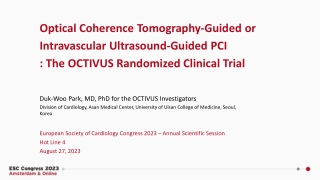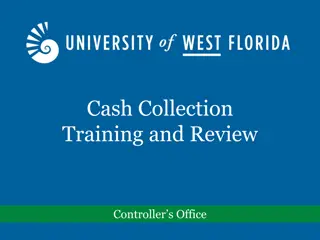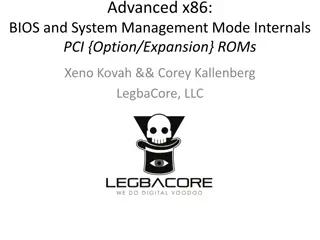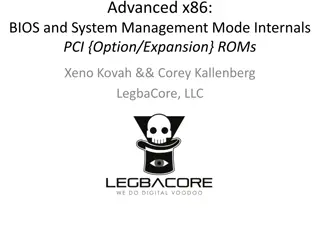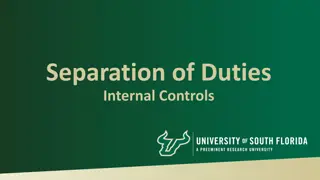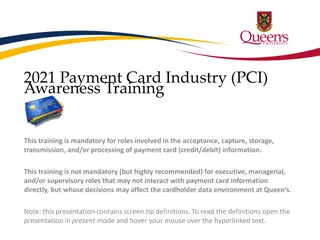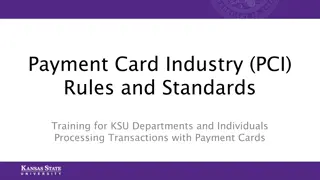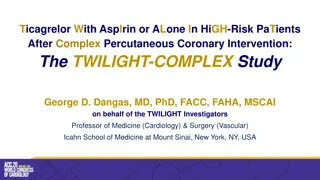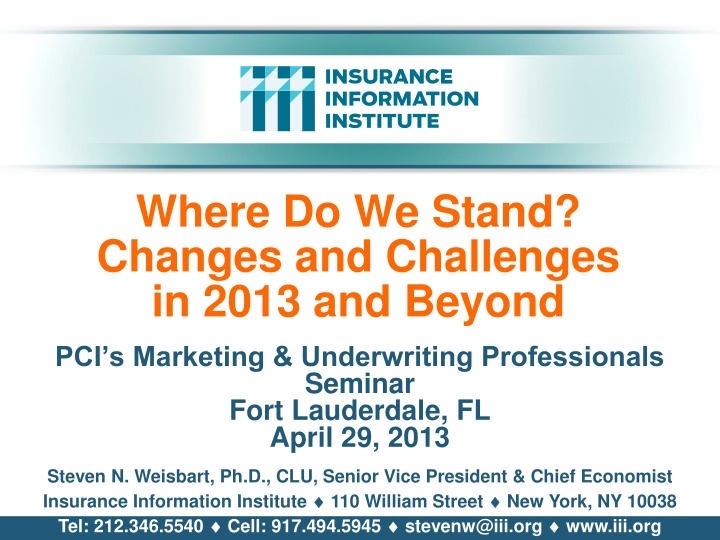
Challenges and Trends in PCI Marketing and Underwriting Seminar 2013
Explore the changes and challenges faced by PCI marketing and underwriting professionals in 2013 and beyond. Discover insights on slow exposure growth, real GDP trends, and the uneven growth in premium writing across different states.
Uploaded on | 2 Views
Download Presentation

Please find below an Image/Link to download the presentation.
The content on the website is provided AS IS for your information and personal use only. It may not be sold, licensed, or shared on other websites without obtaining consent from the author. If you encounter any issues during the download, it is possible that the publisher has removed the file from their server.
You are allowed to download the files provided on this website for personal or commercial use, subject to the condition that they are used lawfully. All files are the property of their respective owners.
The content on the website is provided AS IS for your information and personal use only. It may not be sold, licensed, or shared on other websites without obtaining consent from the author.
E N D
Presentation Transcript
Where Do We Stand? Changes and Challenges in 2013 and Beyond PCI s Marketing & Underwriting Professionals Seminar Fort Lauderdale, FL April 29, 2013 Steven N. Weisbart, Ph.D., CLU, Senior Vice President & Chief Economist Insurance Information Institute 110 William Street New York, NY 10038 Tel: 212.346.5540 Cell: 917.494.5945 stevenw@iii.org www.iii.org
Challenge #1: Slow Exposure Growth Most forecasts see the U.S. and world economies continuing to stumble along 2
Real GDP Growth: Past Recessions and Recoveries, Yearly, 1970-2012 Real GDP Growth (%) In most recoveries, real yearly GDP growth is often 4% or more In the current recovery, real yearly GDP growth has been 2.4% or less 8% 7% 6% 5% 4% 3% 2% 1% 0% -1% -2% But, following the 1991 and 2001 recessions, real yearly GDP growth was weaker than 4% -3% -4% 1970 1971 1972 1973 1974 1975 1976 1977 1978 1979 1980 1981 1982 1983 1984 1985 1986 1987 1988 1989 1990 1991 1992 1993 1994 1995 1996 1997 1998 1999 2000 2001 2002 2003 2004 2005 2006 2007 2008 2009 2010 2011 2012 Source: (GDP) U.S. Department of Commerce at http://www.bea.gov/national/xls/gdpchg.xls. 3
But Overall, Since 2010:Q2, P/C Net Premiums Written Are Growing P/C NPW: % Change, Quarter vs. Year-Prior Quarter This upward trend is likely to continue as the economy s recovery strengthens 16.8% 16.7% 20% 15.1% 13.4% 12.5% 15% 10.3% 10.2% 10.2% 10.1% 9.7% 7.8% 7.2% 10% 6.6% 5.6% 5.5% 5.1% 4.2% 3.8% 3.5% 3.2% 3.1% 2.9% 2.3% 2.1% 5% 1.7% 1.6% 1.3% 0.5% 0.0% 0% -0.7% -1.3% -1.4% -1.6% -1.6% -1.8% -1.9% -5% -3.7% -4.1% -4.4% -4.6% -5.2% Most recent hard market -5.3% -5.8% 2005:Q3 -10% 2002:Q1 2002:Q2 2002:Q3 2002:Q4 2003:Q1 2003:Q2 2003:Q3 2003:Q4 2004:Q1 2004:Q2 2004:Q3 2004:Q4 2005:Q1 2005:Q2 2005:Q4 2006:Q1 2006:Q2 2006:Q3 2006:Q4 2007:Q1 2007:Q2 2007:Q3 2007:Q4 2008:Q1 2008:Q2 2008:Q3 2008:Q4 2009:Q1 2009:Q2 2009:Q3 2009:Q4 2010:Q1 2010:Q2 2010:Q3 2010:Q4 2011:Q1 2011:Q2 2011:Q3 2011:Q4 2012:Q1 2012:Q2 2012:Q3 Finally! A sustained period (10 quarters) of growth in net premiums written (vs. same quarter, prior year), and strengthening. Sources: ISO; Insurance Information Institute. 4
But the Growth Is Uneven: Wide Variation by State (DPW: Total P/C Percent Change for 2006-2011) Top 25 States 80 Just 9 states showed double-digit DPW growth over the 5-year period 2006-2011, which includes the Great Recession 71.5 70 60 Pecent change (%) 50 41.8 40 26.4 30 22.8 22.6 20.8 18.2 20 11.8 10.5 10 6.6 6.3 6.1 5.8 4.9 4.7 4.2 3.9 2.4 2.2 2.1 2.1 2.1 0.9 0.7 0.4 0 WA LA IA AR AK WI WY VT NE KS DE KY MS ND SD OK MN IN NC SC MO NM MT TX TN Sources: SNL Financial, LLC.; Insurance Information Institute. 5
Direct Premiums Written: Total P/C Percent Change by State, 2006-2011 Bottom 25 States States with the poorest performing economies also produced the most negative net change in premiums of the past 5 years 5 0.4 0 -0.6 -0.8 -0.8 -1.1 -1.3 -1.4 -1.6 -1.9 -2.0 Pecent change (%) -2.5 -3.1 -3.2 -5 -3.5 -4.1 -4.4 -5.2 -5.8 -6.0 -10 -10.3 -10.5 -10.8 -11.7 -12.0 -15 -13.5 -20 -19.2 -25 AZ VA AL WV GA PA MA CA NV NJ RI MI HI IL FL NY US ME OH MD ID OR NH CO UT CT Sources: SNL Financial, LLC.; Insurance Information Institute. 6
April 2013 Forecasts of Quarterly US Real GDP for 2013-14 Real GDP Growth Rate 4% 3.9% 3.7% 3.6% 3.6% 3.4% 3.3% 3% 3.0% 2.9% 2.8% 2.7% 2.6% 2.6% 2.4% 2.3% 2% 2.2% 1.8% 2.0% 2.0% 1.7% 1.5% 1% 10 Most Pessimistic Median 10 Most Optimistic Currently, the sequester will have greatest effect here 0.8% 0% 13:Q2 Despite the sequester and other challenges to the U.S. economy, virtually every forecast in the Blue Chip universe in early April sees improvement ahead 13:Q3 13:Q4 14:Q1 14:Q2 14:Q3 14:Q4 Sources: Blue Chip Economic Indicators (4/13); Insurance Information Institute 7
Auto/Light Truck Sales, 1999-2014F Forecast range for 2013 is 14.7 to 15.9 million units (Millions of Units) 19 17.8 17.5 17.4 17.1 16.9 18 16.9 16.6 16.5 16.1 17 Lowest level since the late 1960s 15.9 15.4 16 14.4 15 13.2 14 12.7 13 11.6 12 10.4 11 10 9 99 00 01 02 03 04 05 06 07 08 09 10 11 12 13F 14F Job growth and improved credit market conditions will boost auto sales in 2013 and beyond, bolstering the manufacturing sector and the economy generally. Sources: U.S. Department of Commerce; Blue Chip Economic Indicators (4/13); Insurance Information Institute. 8
PP Auto NWP vs. # of Vehicles in Operation, 2001 2011 $ Billion Private Passenger Auto Premium No. of Vehicles in Operation (millions) $165 250 245 $155 240 235 $145 230 225 $135 220 $125 215 2001 2002 2003 2004 2005 2006 2007 2008 2009 2010 2011 PP Auto premiums written are recovering from a period of no growth attributable to the weak economy affecting new vehicle sales, car choice, and increased price sensitivity among consumers Sources: A.M. Best; NADA, State of the Industry Report 2012, p. 16, at www.nada.org/nadadata citing R. L. Polk; Insurance Information Institute. 9
Something Unusual is Happening: Miles Driven*, 1990 2013 Billions 3,100 1997 vs. 1992: 13.9% 2002 vs. 1997: 11.5% 2007 vs. 2002: 6.1% 2012 vs. 2007: -3.0% Miles Driven Growth per 5-Yr Span 3,000 2,900 2,800 Some of the growth in miles driven is due to population growth: 1997 vs. 1992: +5.1% 2002 vs. 1997: +7.4% 2007 vs. 2002: +4.7% 2012 vs. 2007: +3.4% A record: miles driven has been below the prior peak for 63 straight months. Previous record was in the early 1980s (39 months) 2,700 2,600 2,500 2,400 Will the trend toward hybrid and non-gasoline- powered vehicles affect miles driven? What about the aging and retirement of the baby boomers? 2,300 2,200 2,100 '90 '91 '92 '93 '94 '95 '96 '97 '98 '99 '00 '01 '02 '03 '04 '05 '06 '07 '08 '09 '10 '11 '12 '13 *Moving 12-month total. The latest data is for February 2013. Note: Recessions indicated by gray shaded columns.. Sources: Federal Highway Administration (http://www.fhwa.dot.gov/ohim/tvtw/tvtpage.cfm ); National Bureau of Economic Research (recession dates); Insurance Information Institute. 10
Private Housing Unit Starts, 1990-2014F Millions of Units 2.25 Forecast range for 2013 is 0.89 to 1.35 million units 2.00 2.07 Housing Bubble 1.96 1.85 1.75 1.80 1.71 1.64 1.62 1.60 1.50 1.57 1.48 1.47 1.46 1.36 1.35 1.25 1.29 1.21 1.20 1.19 1.00 1.01 1.00 0.91 Housing unit starts plunged 72% from 2005- 2009 to lowest level since records began in 1959 0.75 0.78 0.61 0.50 0.59 0.55 0.25 90 91 92 93 94 95 96 97 98 99 00 01 02 03 04 05 06 07 08 09 10 11 12 13F 14F Homeowners insurers are starting to see meaningful exposure growth for the first time since 2005. Commercial insurers with construction risk exposure, surety also benefit. Sources: U.S. Department of Commerce; Blue Chip Economic Indicators (4/13); Insurance Information Institute. 11
So Far, the Pickup Is Mostly in Multi-Family Housing Starts Thousands of Units, Single Family units in multi-family buildings single family units Thousands of Units, Multi-Family 400 1800 Multi-family-unit starts now near a pre-recession pace 1600 350 1400 300 1200 Single family plunge began in 2006 250 1000 200 800 Multi-family plunge did not begin until 2009 150 600 100 400 2001 2002 2003 2004 2005 2006 2007 2008 2009 2010 2011 2012 2013* Multi-unit starts, in 2012 at a seasonally adjusted annual rate of 235,000, are double the 2009 rate. Average annual rate for 2001-2006: 339,000. *January-March 2013 data, annualized, seasonally adjusted; March is preliminary. Source: US Census Bureau at www.census.gov/construction/nrc/pdf/newresconst.pdf.
HO Insurance Net Written Premium vs. No. of Housing Units*, 2000 2011 Millions of Occupied Units $ Billions HO premium Number of Housing Units $65 116 $60 112 $55 $50 108 $45 $40 104 $35 $30 100 2000 2001 2002 2003 2004 2005 2006 2007 2008 2009 2010 2011 2012 2013 Homeowners insurance NWP continues rising (up 95% 2000-2011) despite very little unit growth in recent years. Reasons include rate increases, esp *occupied as of start of year indicated Sources: A.M. Best; Insurance Information Institute. 14
Commercial & Industrial Loans Outstanding at FDIC-Insured Banks, Quarterly, 2006-2012* $Trillions In nominal dollar terms, this is an all-time high. Recession $1.6 $1.5 $1.51 $1.50 $1.49 $1.49 $1.48 $1.46 $1.44 $1.43 $1.4 $1.42 $1.39 $1.37 $1.37 $1.35 $1.3 $1.30 $1.28 $1.27 $1.25 $1.24 $1.2 $1.22 $1.21 $1.20 $1.18 $1.18 $1.18 $1.17 $1.17 $1.16 $1.1 $1.13 $1.0 06:Q1 06:Q3 07:Q1 07:Q3 08:Q1 08:Q3 09:Q1 09:Q3 10:Q1 10:Q3 11:Q1 11:Q3 12:Q1 12:Q3 Outstanding loan volume has been growing for over two years and (as of year-end 2012) surpassed previous peak levels. *Latest data as of 4/19/2013. Source: FDIC at http://www2.fdic.gov/qbp/ (Loan Performance spreadsheet); Insurance Information Institute. 15
Percent of Non-current Commercial & Industrial Loans Outstanding at FDIC-Insured Banks, Quarterly, 2006-2012* Almost back to normal levels of noncurrent industrial & commercial loans Recession 4% 3.57% 3.43% 3% 3.05% 2.83% 2.80% 2.73% 2.44% 2.25% 2% 1.89% 1.69% 1.65% 1.49% 1.29% 1% 1.18% 1.17% 1.09% 1.07% 0.97% 0.87% 0.71% 0.70% 0.74% 0.64% 0.63% 0.62% 0.63% 0.67% 0.81% 0% 06:Q1 06:Q2 06:Q3 06:Q4 07:Q1 07:Q2 07:Q3 07:Q4 08:Q1 08;Q2 08:Q3 08:Q4 09:Q1 09:Q2 09:Q3 09:Q4 10:Q1 10:Q2 10:Q3 10:Q4 11:Q1 11:Q2 11:Q3 11:Q4 12:Q1 12:Q2 12:Q3 12:Q4 Non-current loans (those past due 90 days or more or in nonaccrual status) are back to early-recession levels, fueling bank willingness to lend. *Latest data as of 4/19/2013. Source: FDIC at http://www2.fdic.gov/qbp/ (Loan Performance spreadsheet); Insurance Information Institute. 16
Business Bankruptcy Filings: Falling but Still High in 2012 (1994:Q1 2012:Q3) (Thousands) Quarterly average for 2001:Q1-2005:Q3 was 8,915 New Bankruptcy Law Takes Effect 18 11.512.914.316.0 15.0 16 14.6 14.5 14.2 14.0 14.0 14.0 13.9 13.8 13.6 13.5 13.4 13.2 12.013.1 13.0 14 12.9 12.9 12.9 12.8 12.6 12.7 Recessions in orange 12.4 12.4 12.3 12.2 11.7 11.6 11.1 11.0 12 10.6 10.3 9.210.4 10.4 10.3 10.0 10.0 9.9 9.8 7.28.08.79.7 9.7 9.5 9.5 8.18.79.5 9.5 9.4 9.3 10 9.2 9.2 9.0 9.0 8.8 8.4 8.4 8.3 8.2 8.2 7.8 7.6 8 6.7 5.66.3 6 5.3 4.14.9 4 2 0 94:Q1 94:Q3 95:Q1 95:Q3 96:Q1 96:Q3 97:Q1 97:Q3 98:Q1 98:Q3 99:Q1 99:Q3 00:Q1 00:Q3 01:Q1 01:Q3 02:Q1 02:Q3 03:Q1 03:Q3 04:Q1 04:Q3 05:Q1 05:Q3 06:Q1 06:Q3 07:Q1 07:Q3 08:Q1 08:Q3 09:Q1 09:Q3 10:Q1 10:Q3 11:Q1 11:Q3 12:Q1 12:Q3 Business bankruptcies were down 42% in 2012:Q3 vs. recent peak in 2009:Q2 but were still higher than 2008:Q1, the first full quarter of the Great Recession. Bankruptcies restrict exposure growth in all commercial lines. Sources: American Bankruptcy Institute at www.abiworld.org/AM/AMTemplate.cfm?Section=Home&TEMPLATE=/CM/ContentDisplay.cfm&CONTENTID=61633; Insurance Information Institute. 18
Private Sector Business Starts, 1993:Q2 2012:Q2* Business Starts 2006: 861,000 2007: 844,000 2008: 787,000 2009: 701,000 2010: 742,000 2011: 781,000 (Thousands) Recessions in orange 230 209216221 221 221 221 220 216 220 214 213 210 210 204209 203209 204208 208 193200207 207 206 206 199206 206 200206 206 210 199204 204 204 203 192198202 201 201 200 200 199 199 196 200 188195 195 195 194 182187193 193 193 191 191 191 191 184189 189 189 189 188 188 190 185 185 183 175179 172177 180 175 173 169 170 160 150 93:Q2 94:Q1 95:Q1 96:Q1 97:Q1 98:Q1 99:Q1 00:Q1 01:Q1 02:Q1 03:Q1 04:Q1 05:Q1 06:Q1 07:Q1 08:Q1 09:Q1 10:Q1 11:Q1 12:Q1 Business starts were down nearly 20% in the Great Recession, holding back most types of commercial insurance exposure, but now are recovering. * Data through Jun 30, 2012 are the latest available (posted Jan 29, 2013); Seasonally adjusted. Sources: Bureau of Labor Statistics, www.bls.gov/news.release/cewbd.t08.htm; NBER (recession dates). 19 19
Recovery in Capacity Utilization is a Positive Sign for Commercial Exposures March 2001 through Mar. 2013 Full Capacity Percent of Industrial Capacity 82% Hurricane Katrina 80% 78% 76% The closer the economy is to operating at full capacity, the greater the inflationary pressure 74% 72% The US operated at 78.5% of industrial capacity in Feb. 2013, above the June 2009 low of 66.9% and close to its post-crisis peak 70% March 2001- November 2001 recession 68% December 2007- June 2009 Recession 66% Mar 01 Mar 02 Mar 03 Mar 04 Mar 05 Mar 06 Mar 07 Mar 08 Mar 09 Mar 10 Mar 11 Mar 12 Mar 13 Sep Sep Sep Sep Sep Sep Sep Sep Sep Sep Sep Sep Source: Federal Reserve Board statistical releases at http://www.federalreserve.gov/releases/g17/Current/default.htm. 20 20
Challenge #2: Dealing with Catastrophes Are they more frequent and more severe? 21
US Insured Catastrophe Losses ($ Billions, 2012 Dollars) $73.4 $80 2012 CAT losses were down nearly 50% from 2011 until Sandy struck in late October $70 $60 $50 $37.8 $37.0 $34.7 $33.7 $33.1 $29.2 $40 $26.4 $30 $16.3 $14.4 $14.3 $14.0 $12.6 $11.6 $11.5 $11.0 $10.5 $20 $8.8 $8.0 $7.6 $7.5 $6.1 $4.8 $3.8 $10 $0 89 90 91 92 93 94 95 96 97 98 99 00 01 02 03 04 05 06 07 08 09 10 11 12* US CAT Losses in 2012 Will Likely Become the 2nd or 3rd Highest in US History on An Inflation-Adjusted Basis (Pvt Insured). 2011 Losses Were the 5th Highest Record Tornado Losses Caused 2011 CAT Losses to Surge *As of 1/2/13. Includes $20B gross loss estimate for Hurricane Sandy. Note: 2001 figure includes $20.3B for 9/11 losses reported through 12/31/01 ($25.9B 2011 dollars). Includes only business and personal property claims, business interruption and auto claims. Non-prop/BI losses = $12.2B ($15.6B in 2011 dollars.) Sources: Property Claims Service/ISO; Insurance Information Institute. 22 22
Natural Disasters in the United States, 1980 2012 Number of Events (Annual Totals 1980 2012) There were 184 natural disaster events in the US in 2012 300 There were over 150 natural disaster events in the US every year since 2006. That hadn t happened in any year before. 250 200 Number 150 100 41 19 50 121 3 1980 1982 1984 1986 1988 1990 1992 1994 1996 1998 2000 2002 2004 2006 2008 2010 2012 Meteorological (storm) Climatological (temperature extremes, drought, wildfire) Geophysical (earthquake, tsunami, volcanic activity) Hydrological (flood, mass movement) Source: MR NatCatSERVICE 23
The Dozen Most Costly Hurricanes in U.S. History Insured Losses, 2012 Dollars, $ Billions Sandy could become the 2nd costliest hurricane in US insurance history $60 $48.7 $50 Irene became the 12th most expensive hurricane in US history $40 $30 $25.6 $18.8 $20 $13.4 $11.1 $9.2 $8.7 $7.8 $6.7 $10 $5.6 $5.6 $4.4 $0 Irene (2011) Jeanne (2004) Frances (2004) Rita (2005) Hugo (1989) Ivan (2004) Charley (2004) Wilma (2005) Ike (2008) Sandy* (2012) Andrew (1992) Katrina (2005) 10 of the 12 costliest hurricanes in private insurance history occurred in the past 9 years (2004 2012) *Estimate as of 12/09/12 based on estimates of catastrophe modeling firms and reported losses as of 1/12/13. Estimates range up to $25B. Sources: PCS; Insurance Information Institute inflation adjustments to 2012 dollars using the CPI. 24
If They Hit Today, the Dozen Costliest (to Insurers) Hurricanes in U.S. History Insured Losses, 2012 Dollars, $ Billions $140 businesses to damage, so simply adjusting their actual claims for inflation doesn t capture their Storms that hit long ago had less property and $125 $120 destructive power. Karen Clark s analysis aims to overcome that. $100 $80 $65 $60 $50 $50 $50 $40 $40 $35 $40 $25 $20 $20 $20 $20 $0 Sandy* (2012) Betsy (1965) Hazel (1954) Donna (1960) New England (1938) Katrina (2005) Galveston (1915) Andrew (1992) south- Florida (1947) Galveston (1900) mid- Florida (1928) Miami (1926) When you adjust for the damage prior storms could have done if they occurred today, Hurricane Katrina slips to a tie for 6th among the most devastating storms. *Estimate as of 12/09/12 based on estimates of catastrophe modeling firms and reported losses as of 1/12/13. Estimates range up to $25B. Sources: Karen Clark & Company, Historical Hurricanes that Would Cause $10 Billion or More of Insured LossesToday, August 2012; I.I.I. 25
P/C Industry Homeowners Claim Frequency, US, 1997-2011 Claims Paid per 100 Exposures CAT-related claims Non-CAT-related claims All Claims 10 9.53 8.85 8.79 8.56 8 8.10 7.99 7.52 7.46 7.30 6.99 6.71 6.61 6.55 6.53 6.52 6.45 6.40 6.26 6 6.05 5.83 5.26 4.63 4.174.31 4.16 4 4.03 3.94 3.83 3.77 3.68 3.64 3.42 2.97 2.82 2.67 2.57 2.39 2.34 2.35 2.32 2.28 2 1.84 1.69 1.57 1.32 0 1997 1998 1999 2000 2001 2002 2003 2004 2005 2006 2007 2008 2008 2010 2011 Sources: Insurance Research Council, Trends in Homeowners Insurance Claims, p.29; Insurance Information Institute
P/C Industry Homeowners Average Claim Severity, 1997-2011 non-cat claims cat claims $9,000 $8,000 $7,000 $6,000 HO average claim severity is now three times what it was in 1997. $5,000 $4,000 $3,000 $2,000 1997 1998 1999 2000 2001 2002 2003 2004 2005 2006 2007 2008 2009 2010 2011 Sources: Insurance Research Council, Trends in Homeowners Insurance Claims, p. 29, BLS inflation calculator, and Insurance Information Institute
Superstorm (barely a CAT 1) Sandy: 1.4 million Claims, by Type* Sandy caused an estimated 1.4 million privately insured claims resulting in an estimated $15 to $25 billion in insured losses. Hurricane Katrina produced 1.74 million claims and $47.6B in losses (in 2011 $) Commercial , 167,500 , 12% Auto, 230,500 , 17% Homeowner , 982,000 , 71% Sandy was a high-frequency, (relatively) low-severity event (avg. severity <50% Katrina) *PCS claim count estimate as of 11/26/12. Loss estimate represents high and low end estimates by risk modelers RMS, Eqecat and AIR. PCS estimate of insured losses as of 11/26/12 $11 billion. All figures exclude losses paid by the NFIP. Source: PCS; AIR, Eqecat, AIR Worldwide; Insurance Information Institute. 28
Flood-Damaged Structures with/without Flood Insurance: Long Island NY 62.5% of flood-damaged buildings in Nassau County were uninsured for flood Number of structures 80,000 74,736 70,000 46,681 60,000 73.4% of flood-damaged buildings in Suffolk County were uninsured for flood 50,000 Uninsured Insured 40,000 46,681 30,000 $2.2 20,798 28,055 20,000 15,051 5,747 10,000 5,747 0 Nassau Suffolk Here s a marketing challenge. Most people who live on the coast in Long Island didn t buy flood insurance. Source: Newsday, 1/14/13 from FEMA and Small Business Administration. 30 30
Residential NFIP Flood Take-Up Rates in NY, CT (2010) & Sandy Storm Surge Less than 5% penetration! Flood insurance penetration rates were under 15% in many very vulnerable areas of NY and CT. These coastal areas should have take-up rates of 75% and over Source: Wharton Center for Risk Management and Decision Processes, Issue Brief, Nov. 2012; Insurance Information Institute. 31
Challenge #3: Prolonged Low Investment Gains Investment Performance is a Key Driver of Profitability 32
U.S. Treasury Security Yields*: A Long Downward Trend, 1990 2013 9% Yields on 10-Year U.S. Treasury Notes have been essentially below 5% for a full decade. 8% U.S. Treasury security yields recently plunged to record lows 7% 6% 5% 4% 3% 2% Recession 2-Yr Yield 10-Yr Yield 1% 0% '90 '91 '92 '93 '94 '95 '96 '97 '98 '99 '00 '01 '02 '03 '04 '05 '06 '07 '08 '09 '10 '11 '12 '13 Since roughly 80% of P/C bond/cash investments are in 10-year or shorter durations, most P/C insurer portfolios will have low-yielding bonds for years to come. *Monthly, constant maturity, nominal rates, through March 2013. Sources: Federal Reserve Bank at http://www.federalreserve.gov/releases/h15/data.htm. National Bureau of Economic Research (recession dates); Insurance Information Institutes. 33 33
Distribution of Bond Maturities, P/C Insurance Industry, 2003-2011 2011 15.2% 41.4% 26.8% 10.3% 6.3% 16.3% 39.5% 26.7% 11.1% 6.4% 2010 2009 16.2% 36.2% 28.7% 11.7% 7.3% Under 1 year 1-5 years 5-10 years 10-20 years over 20 years 15.7% 32.4% 31.2% 12.7% 8.1% 2008 2007 15.2% 30.0% 33.8% 12.9% 8.1% 2006 16.0% 29.5% 34.1% 13.1% 7.4% 2005 16.0% 28.8% 34.1% 13.6% 7.6% 2004 15.4% 29.2% 32.5% 15.4% 7.6% 2003 14.4% 29.8% 31.3% 15.4% 9.2% 0% 20% 40% 60% 80% 100% The main shift over these years has been from bonds with longer maturities to bonds with shorter maturities. The industry first trimmed its holdings of over-10-year bonds (from 24.6% in 2003 to 16.9% in 2011) and then trimmed bonds in the 5-10-year category. Falling average maturity of the P/C industry s bond portfolio is contributing to a drop in investment income along with lower yields. Sources: A.M. Best; Insurance Information Institute. 34
Purchasing Power of P/C Industry Investment Gains: 1994 2012F1 ($ Billions, 2012 dollars) Average yearly gain: $60.85B. We haven t hit that average in the last 5 years. $90 $81.7 $75.9 $74.8 $71.5 $70.9 $69.8 $69.1 $64.5 $63.4 $56.5$59.4 $57.6 $56.2$57.4 $60 $54.8 $50.8 $45.9 $42.0 $33.8 $30 94 95 96 97 98 99 00 01 02 03 04 05* 06 07 08 09 10 11 12F In 2012 (1st three quarters) both investment income and realized capital gains were lower than in the comparable period in 2011. And because the Federal Reserve Board aims to keep interest rates exceptionally low until the unemployment rate hits 6.5% likely at least another year off maturing bonds will be re-invested at even lower rates. 1Investment gains consist primarily of interest, stock dividends and realized capital gains and losses. *2005 figure includes special one-time dividend of $3.2B; 2012F figure is I.I.I. estimate based on annualized actual 2012:Q3 result of $38.089B. Sources: ISO; Insurance Information Institute.
Challenge #4: Inflation and P/C Claims 38
Change* in the Consumer Price Index, 20042013 14% Recession CPI Core CPI For two months in 2008, led by gasoline, the general price level was rising at a 5.5% pace 12% 10% 8% 6% 4% 2% 0% -2% -4% '04 Over the last decade, prices generally rose about 2% per year. '05 '06 '07 '08 '09 '10 '11 '12 '13 *Monthly, year-over-year, through March 2013. Not seasonally adjusted. Sources: US Bureau of Labor Statistics; National Bureau of Economic Research (recession dates); Insurance Information Institutes. 39 39
Prices for Hospital Services: 12-Month Change,* 1998 2013 Recession Outpatient Services Inpatient Services 14% 12% 10% 8% 6% 4% 2% 0% '98 Cyclical peaks in PP Auto tend to occur approximately every 10 years (early 1990s, early 2000s, and possibly the early 2010s) '99 '00 '01 '02 '03 '04 '05 '06 '07 '08 '09 '10 '11 '12 '13 *Percentage change from same month in prior year; through January 2013; seasonally adjusted Sources: US Bureau of Labor Statistics; National Bureau of Economic Research (recession dates); Insurance Information Institute. 40
Forces that Drive Car Repair Costs: 12-Month Change,* 2001 2013 Recession Auto repair Auto body work 14% 12% 10% 8% 6% 4% 2% 0% '01 '02 '03 '04 '05 '06 '07 '08 '09 '10 '11 '12 '13 Cyclical peaks in PP Auto tend to occur approximately every 10 years (early 1990s, early 2000s, and possibly the early 2010s) *Percentage change from same month in prior year; through January 2013; seasonally adjusted Sources: US Bureau of Labor Statistics; National Bureau of Economic Research (recession dates); Insurance Information Institute. 41
Change* in Price Index for Lumber: A Downward Trend but Sudden Spikes, 2004 2013 40% But 30% spikes can happen with no warning Recession Hardwood Softwood Lumber 35% The price of lumber dropped before and during the recession 30% 25% 20% 15% 10% 5% 0% -5% -10% -15% -20% '04 '05 '06 '07 '08 '09 '10 '11 '12 '13 The prices of building materials vary wildly and change levels rapidly. Prices for hardwood have been much less variable than softwood lumber. *Monthly, year-over-year, through March 2013. Not seasonally adjusted. Dec. 2012 and Jan., Feb., and Mar. prices are preliminary. Sources: US Bureau of Labor Statistics, Producer Price Index series WPS0811; National Bureau of Economic Research (recession dates); Insurance Information Institutes. 42 42
Change* in Price Index for Plywood: A Downward Trend but Sudden Spikes, 2004 2013 60% Recession The price of plywood rose by 50% in late Spring 2004 over the prior year Plywood 50% 40% March 2013: +8.4% 30% 20% 10% 0% -10% -20% -30% '04 '05 '06 '07 '08 '09 '10 '11 '12 '13 From the end of the recession (June 2009) to March 2013, the effect of the ups and downs of the price of plywood has resulted in a rise of 25.6%. *Monthly, year-over-year, through March 2013. Not seasonally adjusted. Dec. 2012 and Jan., Feb., and Mar. prices are preliminary. Sources: US Bureau of Labor Statistics, Producer Price Index series WPU083; National Bureau of Economic Research (recession dates); Insurance Information Institutes. 43 43
Challenge #5: Regulatory Pressure? From Congress (TRIA), HUD, CFPB, FSOC/Federal Reserve (SIFIs), the NAIC s SMI, etc. 44
I.I.I. Congressional Testimony on the Future of the Terrorism Risk Insurance Program Issue: Act expires 12/31/14. Insurers still generally regard large-scale terror attacks as fundamentally uninsurable I.I.I. Input: Testified at first hearing on the issue in DC (on 9/11/12) on trends in terrorist activity in the US and abroad, difficulties in underwriting terror risk; Noted that bin Laden may be dead but war on terror is far from over Status: New House FS Committee Chair Jeb Hensarling has opposed TRIA in the past; Obama Administration does not seem to support extension; Little institutional memory on insurance subcommittee Media: Virtually no media coverage yet apart form trade press; WSJ will likely editorialize against it. Objective: Work with trades, risk management community and others to help build support 45
Loss Distribution by Type of Insurance from Sept. 11 Terrorist Attack ($ 2011) ($ Billions) Property - WTC 1 & 2* $4.4 (11%) Life Other Liability $4.9 (12%) $1.2 (3%) Property - Other $7.4 (19%) Aviation Liability $4.3 (11%) Biz Interruption $13.5 (33%) Event Workers Comp $2.2 (6%) Cancellation $1.2 (3%) Aviation Hull $0.6 (2%) Total Insured Losses Estimate: $40.0B** *Loss total does not include March 2010 New York City settlement of up to $657.5 million to compensate approximately 10,000 Ground Zero workers or any subsequent settlements. **$32.5 billion in 2001 dollars. Source: Insurance Information Institute.
Exhibit 3A Terrorism Violates Traditional Requirements for Insurability Requirement Estimable Frequency Definition Insurance number of observations to develop predictive making models (an actuarial concept known as credibility) Violation Very few data points Terror modeling still in infancy, untested. Inconsistent assessment of threat requires large rate- Potential virtually unbounded. Losses exceed insurer capital resources for paying claims. Extreme workers compensation and statute exclusions. loss is Maximum possible/ probable loss must be estimable in order to minimize risk of ruin (insurer cannot run an unreasonable risk of insolvency though assumption of the risk) Estimable Severity at least can easily risk in forbids Source: Insurance Information Institute
Terrorism Violates Traditional Requirements for Insurability (cont d) Requirement Definition Diversifiable Risk Violation Losses likely highly concentrated geographically or by industry (e.g., WTC, power plants) Must spread/distribute across large number of risks Law of Numbers helps makes losses manageable and less volatile Probability occurring purely random fortuitous Events are individually unpredictable in terms of time, location and magnitude be able to risk Large Terrorism attacks are planned, coordinated and deliberate acts of destruction Dynamic target shifting from hardened targets to soft targets Terrorist adjust tactics to circumvent new security measures Actions of US and foreign govts. may affect likelihood, nature and timing of attack of loss be and Random Loss Distribution/ Fortuity must Source: Insurance Information Institute
The New HUD Ruling HO Underwriting vs. Disparate Impact 49
What Did HUD Rule? The Fair Housing Act prohibits discrimination in the sale, rental, or financing of dwellings on the basis of race, color, religion, sex, disability, familial status, or national origin. HUD s rule says Plaintiffs may use statistical analysis to show that certain insurer/lender/municipality behavior had a disproportionately adverse effect on the sale, rental, or financing of housing for minorities Under the rule, this showing violates the federal Fair Housing Act even if the insurer/lender/municipality did not intend to discriminate Defendant can prevail if it shows the practice was needed to achieve one or more substantial, legitimate, nondiscriminatory interests But plaintiff may win by showing that another practice with a less discriminatory effect could achieve this interest 50
Potential Impact on Property Insurance Underwriting Why does this affect property insurance? Insurers don t use race, religion, sex, etc. to underwrite property insurance But they do use credit-based insurance scores, neighborhood, and other factors that could be the basis of a disparate impact conclusion Isn t this a federal government agency s intrusion into state regulation, against McCarran-Ferguson? HUD says M-F says federal laws/regulations that specifically relate to the business of insurance supercede state law But how can insurers defend themselves if they don t have data on race (which they re prohibited from collecting)? HUD says plaintiff have the same problem, so it s fair 51
Other Regulatory Challenges? Designating Some Insurers as Systemically Important? Creating a two-tiered, unlevel playing field Extending the Reach of the Consumer Financial Protection Bureau? The CFPB is now proposing regulations for mortgage servicers regarding property insurance on homes with mortgages Will it deal with insurance offered with credit cards? Bank marketing of insurance products? 53
Key Takaways 54 54
Takeaways: Insurance Industry Predictions for 2013 P/C Insurance Exposures Will Grow With the U.S. Economy Personal and commercial exposure growth is likely in 2013 But restoration of destroyed exposure will take until mid-decade Wage growth is also positive and could modestly accelerate P/C Industry Growth in 2013 Will Be Strongest Since 2004 Growth likely to exceed A.M. Best projection of +3.8% for 2012 No traditional hard market emerges in 2013 Underwriting Fundamentals Deteriorate Modestly Some pressure from claim frequency, severity in some key lines But WC will be tough to fix Industry Capacity Hits a New Record by Year-End 2013 (Barring Meg-CAT) Investment Environment Is/Remains Challenging Interest rates remain low 55
Insurance Information Institute www.iii.org Thank you for your time and your attention!



